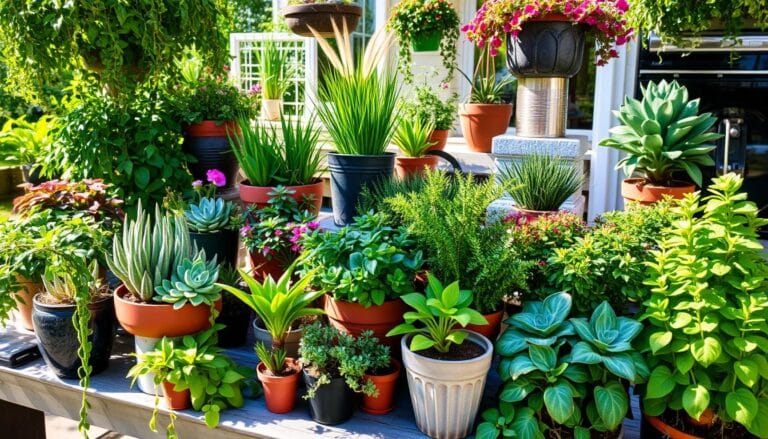Green Space Design Ideas with Ornamental Plants

Turning your outdoor areas into lush, vibrant gardens is exciting. By using ornamental plants, you can make stunning green spaces. These spaces can bring peace and natural beauty to your backyard, patio, or indoor areas.
Table of Contents
Understanding the Fundamentals of Green Space Design
Creating beautiful and thriving green spaces starts with knowing the basics of landscape design. Whether you’re making an ornamental garden or a lush botanical canvas, getting the fundamentals right is crucial. It helps you achieve the garden scenery you dream of.
Basic Design Principles for Ornamental Gardens
An ornamental garden is a masterpiece, blending foliage texture, color, and form. Key design principles like balance, rhythm, and focal points help place and choose plants. This ensures a cohesive and stunning garden.
Essential Elements of Plant Selection
- Think about plant size, growth habits, and mature foliage
- Choose colors and textures that complement each other
- Ensure plants offer interest all year round
- Pick species that are easy to care for and can handle drought
Climate Considerations for Successful Planning
The local climate is vital for your green space’s success. Knowing your area’s temperature, rainfall, and sunlight helps pick the right plants. This way, you can create a garden that’s not only beautiful but also sustainable and resilient.
| Climate Zone | Suitable Plant Choices | Watering Needs |
|---|---|---|
| Temperate | Hydrangeas, Azaleas, Rhododendrons | Moderate, with consistent moisture |
| Mediterranean | Lavender, Rosemary, Olive Trees | Low, with occasional deep watering |
| Tropical | Palms, Bromeliads, Philodendrons | High, with frequent and generous watering |
“The true essence of a garden lies in its ability to transport us to a world of tranquility and natural beauty.”
By grasping the basics of green space design, you can craft a stunning botanical canvas that shows off your style. Following these principles ensures your garden is not just beautiful but also enduring.
Creating Your Perfect Green Space Background
Designing a lush, verdant tapestry as the backdrop for your green space can transform any outdoor area into a serene, nature-inspired haven. Whether you’re working with a small balcony or a sprawling garden, the key is to layer a harmonious blend of ornamental plants, textures, and colors to create a forest mural-like effect.
Start by considering the overall size and layout of your space. For compact areas, focus on incorporating a variety of potted plants, trailing vines, and compact shrubs to create a sense of depth and visual interest. In larger spaces, you can showcase the lush greenery of towering trees, cascading foliage, and a mix of perennials and annuals to craft a truly immersive, forest mural-inspired backdrop.
When selecting your plant palette, look for a mix of species that offer varying heights, foliage shapes, and hues. Incorporate a balance of evergreen and deciduous plants to ensure year-round visual interest. Consider incorporating bold-leaved tropicals, delicate ferns, and fragrant flowering shrubs to add depth and texture to your verdant tapestry.
| Plant Type | Recommended Varieties | Design Considerations |
|---|---|---|
| Evergreen Trees | Magnolia, Camellia, Rhododendron | Provide structure and year-round interest |
| Deciduous Shrubs | Hydrangea, Azalea, Viburnum | Add seasonal color and visual depth |
| Perennial Flowers | Hostas, Ferns, Irises | Create a lush, layered effect |
Remember, creating the perfect green space background is all about striking a balance between structure, texture, and color. By thoughtfully combining a variety of ornamental plants, you can craft a forest mural-like backdrop that will serve as the foundation for your dream outdoor oasis.

Vertical Gardens and Living Walls for Modern Spaces
Urban living is on the rise, making it key to find creative ways to add plant backdrops and botanical canvas to small spaces. Vertical gardens and living walls are a great solution. They turn green space background into a lively, space-saving feature.
Structural Requirements for Vertical Gardens
Building a vertical garden needs careful planning and the right structure. The wall or support must be strong enough to hold the plants, soil, and water system. It’s also important to have good drainage to avoid mold or damage.
Best Plants for Living Wall Systems
Choose plants for your living wall that do well in shallow soil and unique growing conditions. Succulents, ferns, vines, and easy-to-care-for herbs are great options. Make sure to pick plants that fit your space’s light and water needs for a beautiful display.
Maintenance Tips for Vertical Green Spaces
- Water plants regularly but avoid too much water.
- Trim plants to keep them looking neat and promote growth.
- Watch for pests or diseases and treat them quickly.
- Replace soil or growing medium as needed to feed the plants.
Adding vertical gardens and living walls to your green space background can change small urban areas into lush, botanical canvas. It brings nature right into your daily life.
Incorporating Water Features and Botanical Elements
To make your garden look like a real nature spot, it’s not just about picking the right ornamental plants. Adding cool water features and different plants can make your garden look amazing. This mix can turn your outdoor area into a peaceful place that feels like nature.
Water features like small fountains or serene ponds bring calm to your garden scenery. They not only look and sound good but also attract animals. This makes your garden even greener and more lively. Think about the size, shape, and where to put these features to fit your garden well.
Combining water features with the right ornamental plants makes your garden magical. Aquatic plants like water lilies or lotus flowers do well near water. Trailing vines and cascading foliage add softness and depth. Try different plants to make your garden look like a nature scene.
Getting water features and plants right is all about balance. By carefully adding these, you can make your garden a peaceful oasis. Here, you can enjoy the beauty of a lush greenery-filled space.
Sustainable Practices in Ornamental Plant Design
Creating a lush green space needs careful planning. Choose plants that are good for the environment. Use water wisely and control pests naturally. This way, you’ll have a beautiful, easy-to-care-for outdoor area.
Eco-friendly Plant Selection
Choosing the right plants is key to a sustainable garden. Pick native plants that grow well in your area. They need less water and care, making your garden look great and helping local wildlife.
Water Conservation Strategies
Water is very important. Use smart ways to save it in your garden. Pick plants that don’t need much water and use rainwater. These steps keep your garden green and save water.
Natural Pest Control Methods
Keeping your plants healthy means using natural pest control. Introduce helpful insects and use organic pesticides. This approach keeps your garden healthy and protects the environment.
FAQ
What are the basic design principles for creating ornamental gardens?
To design ornamental gardens, balance colors, textures, and heights. Add focal points and interest. Plan for all seasons and think about scale and proportion. This makes your garden look good and feel right.
How do I select the right plants for my green space background?
Pick plants that fit your climate and look good. Mix evergreen and seasonal plants for year-round beauty. Choose native plants that grow well in your area.
What are the essential elements of a successful vertical garden or living wall system?
A strong support, irrigation, and the right plants are key. Use good soil and keep it up for a beautiful vertical garden.
How can I incorporate water features into my ornamental plant design?
Water features like fountains add beauty and calm. Think about size, placement, and plants that go well together. This makes your garden peaceful and pretty.
What are some sustainable practices I can implement in my ornamental plant design?
Use native or drought-tolerant plants and save water with drip irrigation. Natural pest control is better for the environment. These steps make your garden beautiful and good for the planet.
There are no reviews yet. Be the first one to write one.






